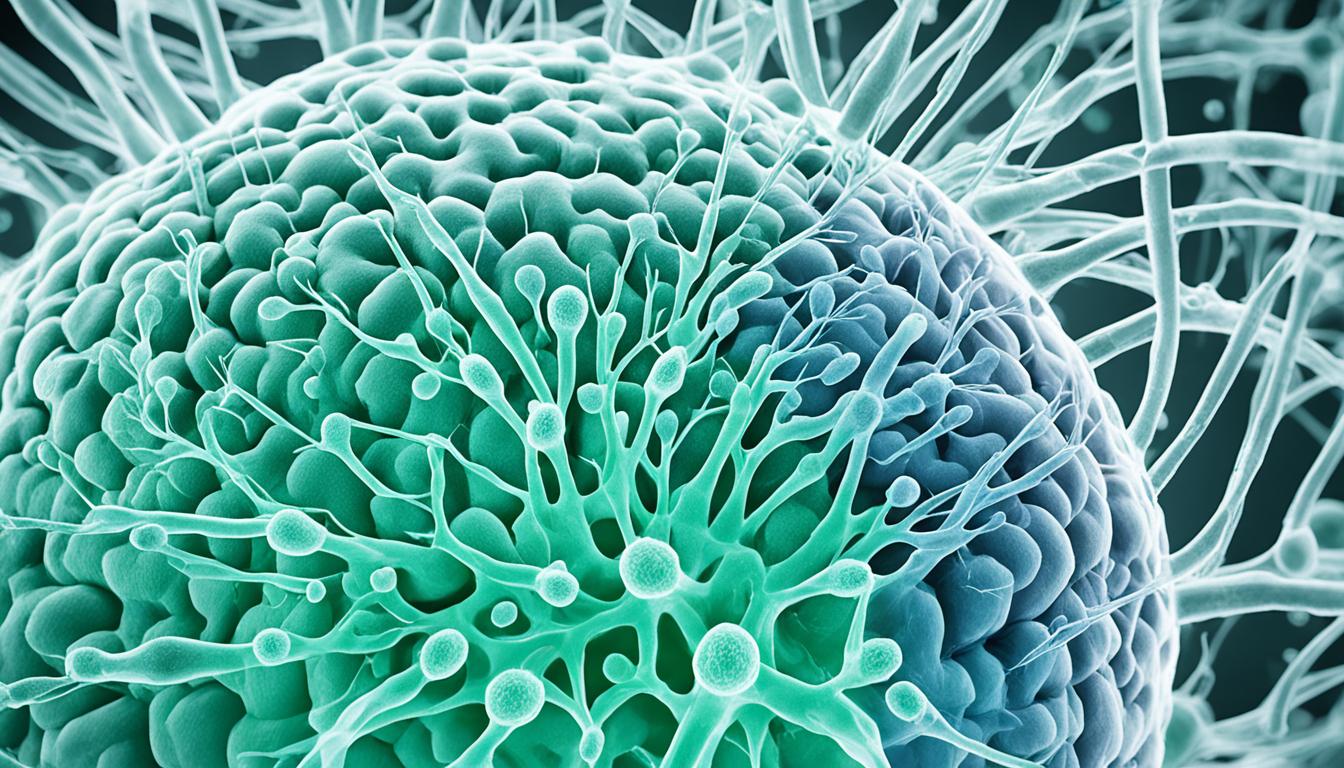Myelin oligodendrocyte glycoprotein antibody-associated disease (MOGAD) is rare. It inflames the central nervous system, affecting the optic nerves, brain, and spinal cord. The immune system attacks the protective substance on nerve fibers. This can cause symptoms like vision loss, muscle problems, confusion, seizures, and headaches.
These signs are similar to multiple sclerosis. So, getting the right diagnosis is very important. This helps distinguish MOGAD from other illnesses and plan the correct treatment.
Although MOGAD has no cure, there are ways to help. Treatments aim to control the immune system and decrease swelling. Activities like physical and occupational therapy can also make life better for those with MOGAD.
Stem cell therapy is being looked into for treating MOGAD. Stem cells may be able to fix damaged myelin in the brain and spinal cord. This research hopes to slow down the disease.
Key Takeaways:
- MOGAD is a rare inflammatory disease that affects the central nervous system.
- Symptoms of MOGAD include vision loss, muscle weakness, confusion, seizures, and headaches.
- Proper diagnosis is important to differentiate MOGAD from other conditions with similar symptoms.
- Treatments for MOGAD focus on managing symptoms, suppressing the immune system, and reducing inflammation.
- Stem cell therapy is a promising area of research in the treatment of MOGAD, aiming to repair damaged myelin.
Symptoms and Diagnosis of MOGAD
Myelin Oligodendrocyte Glycoprotein Antibody-Associated Disease (MOGAD) causes inflammation in the central nervous system. This leads to several symptoms. The main ones are vision loss, eye pain, difficulty moving your eyes, weakness, stiffness, and other issues.
- Optic Neuritis: affects the optic nerve, causing vision loss, eye pain, and trouble moving your eyes.
- Transverse Myelitis: inflames the spinal cord, leading to weakness, stiffness, and more.
- Acute Disseminated Encephalomyelitis (ADEM): affects the brain and spinal cord, causing weakness, trouble walking, and confusion.
- Other symptoms may include seizures, headaches, and fever.
Diagnosing MOGAD requires looking at your health history, a physical exam, and various tests. Doctors often use MRI to see inflammation or damage. Blood tests check for MOG antibodies, helping to tell it apart from other diseases. Seeing a neurologist who knows about autoimmune conditions is very important for the correct treatment.
Diagnostic and Differentiating Features of MOGAD
| Criteria | MOGAD | Other Similar Conditions |
|---|---|---|
| Typical Symptoms | Includes optic neuritis, transverse myelitis, ADEM | May have optic neuritis, multiple sclerosis, or neuromyelitis optica symptoms |
| MOG Antibody Testing | Will show as positive | Will show as negative |
| MRI Findings | Shows lesions in the central nervous system of various sizes and places | Shows lesions specific to the related condition |
| Disease Course | Might happen once or come back at times | Course of disease varies by condition |
Getting a quick and accurate diagnosis is very important for managing MOGAD. If you have the symptoms or any risk factors, see a doctor. They can start the right treatment for you.
Causes, Risk Factors, and Complications of MOGAD
MOGAD is thought to be caused by the immune system mistakenly attacking its own body. It targets myelin, a protective layer around nerve fibers. This happens in the central nervous system.
The exact cause of this immune response is not clear. But, age appears to play a role. Children and young adults seem to face a higher risk.
Recent infections or vaccines like the SARS-CoV-2 virus might trigger MOGAD. But how this happens is not fully understood yet.
MOGAD can lead to serious health problems. It can cause permanent paralysis and affect body functions like those of the bowel and bladder. It could also lead to blindness and problems with memory and thinking.
Unfortunately, treating MOGAD can also pose risks. Some medications might make infections more likely. In children, these treatments might slow down their growth.
Summary of Causes, Risk Factors, and Complications of MOGAD:
| Causes | Risk Factors | Complications |
|---|---|---|
| Autoimmune disorder | Age (children and young adults) | Permanent paralysis |
| Immune system dysfunction | Recent infection or vaccination | Bowel and bladder difficulties |
| Myelin destruction | Blindness | |
| Cognitive impairments | ||
| Infections | ||
| Slowed growth and development (in children) |
Stem Cell Therapy for MOGAD
Stem cell therapy is a very promising area for MOGAD treatment. It aims to use the body’s own healing power. This helps it restore damaged tissues and improve how patients do. Stem cells can become many kinds of cells. This makes them a good fit for fixing the myelin in MOGAD.
Early studies and trials with stem cell therapy in MOGAD look good. This new way of treating the disease has helped patients. It has made their symptoms better and slowed down the disease. But, we still need more research to know all the good it can do and its effects over time.
There’s a lot of work going on in stem cell therapy for MOGAD. This gives hope for learning how to make the treatment even better. Using stem cells is a new and exciting path for helping people with this rare disease.
As we keep looking into stem cell therapy, it brings a lot of hope for MOGAD. Scientists and doctors are studying how it might help. They want to understand its full benefits. This could change how we treat and improve the lives of MOGAD patients and their families.

